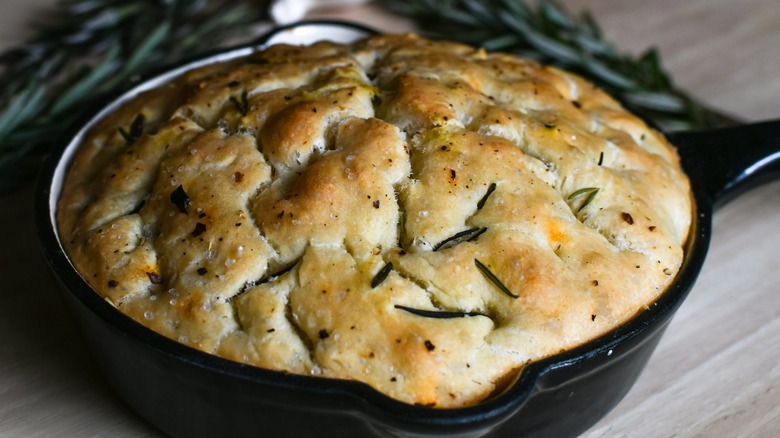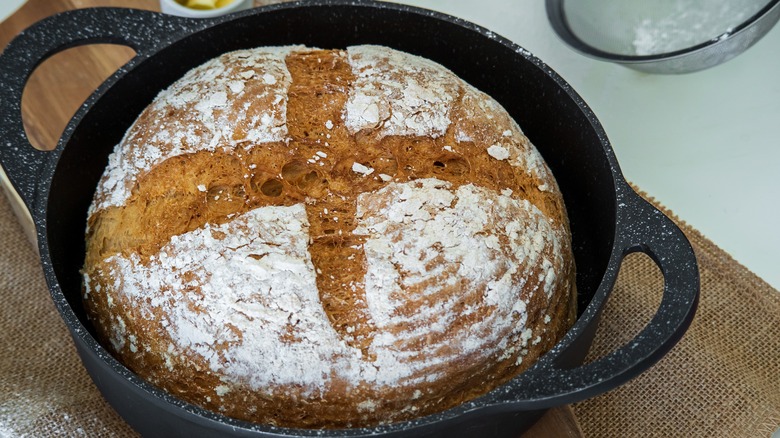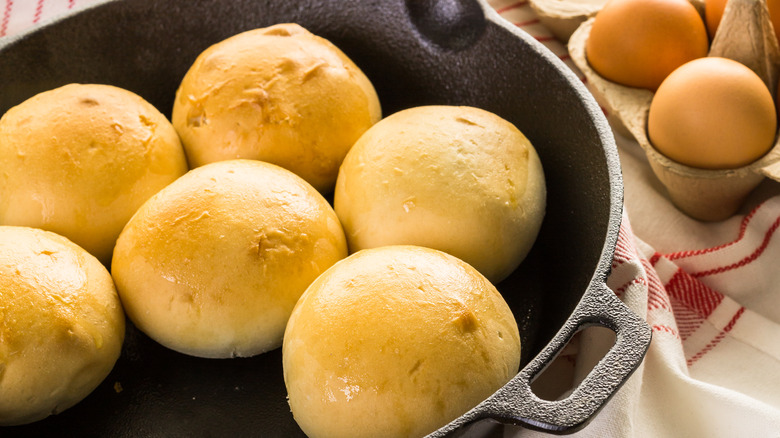Cast Iron Pans Yield The Crunchiest Bread Loaves, But There's A Catch
There are a few characteristics that distinguish good homemade bread from great, even before you take a bite. The crust should be crispy and range in color from light to golden brown, the crumb should have large air bubbles for a tender and springy interior, and the yeasty smell should make your mouth water as you wait for it to cool enough to handle. If these three factors are present, the flavor is likely not to disappoint.
There are many types of bread: some baked tall in a pan, like sandwich bread; some barely rising, like flatbread; or falling somewhere in between, like French bread. Bakers debate the best methods to cook each type, varying the proper pan to achieve the desired results. For flatbreads, however, a cast iron pan can provide the best results, with one caveat.
Used for generations to cook everything from cornbread to fried chicken, cast iron skillets can be used to make all sorts of bread loaves — like roasted red pepper focaccia — with the crunchiest bottom crust. But since cast iron takes longer to heat than other materials, breads baked in it take longer if the pan isn't preheated. While this might add five to 10 minutes to the cooking time, the delightfully crunchy end result is worth it.
Tips for baking bread in a cast iron
One of the benefits of cooking in cast iron is its ability to retain heat well, ensuring a delicious crust on anything cooked in it. The pan is usually preheated, but for some bread recipes like focaccia, which are formed in the pan, preheating isn't possible. When baking bread in cast iron, whether it's a sourdough farm loaf or focaccia, there are a few things to keep in mind.
Scorching may occur on the bottom crust when the bread is cooked with a single heating source underneath. Breadmaker Erin Slonakar told cast iron manufacturer Lodge that using a heat shield — such as an empty, clean baking sheet — on the bottom rack of the oven to reduce direct heat on the pan can help prevent this.
A seasoned cast iron pan is needed to keep the surface nonstick, but excessive leftover grease can cause the bottom to burn and create smoke in the oven, affecting the bread's flavor. Wipe the surface with paper towels, then lightly brush with a neutral oil or cooking spray for easy bread release post-baking. Some bakers like to sprinkle the bottom with semolina or flour, which helps prevent the dough from sticking.
While parchment paper is sometimes used in Dutch ovens for baking boules, it's not recommended in an open skillet. The paper is only oven-safe up to 425 degrees Fahrenheit, and can ignite if it touches an open flame or the oven's walls.
How to create a crunchy top crust using cast iron
A cast iron pan effortlessly delivers the crunchiest bottom crust, but what if the recipe calls for the entire exterior to be browned? Here are some tips for creating golden brown crusty loaves and rolls using cast iron pans.
During the final proof, use a banneton or brotform instead of a mixing bowl. These linen-lined wicker baskets draw out some moisture from the dough, aiding crust development. Before baking, score the bread a quarter of an inch deep using a bread lame or razor. This can be decorative, but it also allows steam to escape, enabling the dough to expand and become airy. If the surface is floured, cold, and dry from using a banneton, the dough won't snag as you slash.
Most importantly, steam is necessary, which is why Dutch ovens are popular in home kitchens. They trap the dough's moisture, but if you use a cast iron skillet without a lid, you need to create a similar environment. Start by placing another cast iron or stainless steel skillet with a half cup of boiling water in the bottom of the oven just before adding the bread. This creates a steamy environment during the initial baking stage. Avoid opening the oven once the bread is baking, or the steam will escape. Spritzing the bread's surface with water before placing it in the oven also helps develop a crust.



